It's like opening Pandora's Box. Inside there's a forgotten store of good and bad waiting to pop out - in this case, out of a packing box in my spare room has tumbled a series of news cuttings, magazine articles and stories that I'd forgotten that I'd collected whilst living in England. The following magazine article appeared in Asiaweek, published in Hong Kong, in March 2001 and it sounds a warning about the lure of visitors to Cambodia in the wake of the movie, Tomb Raider. There are a couple of tenuous links, one is that Paramount Pictures' location chief Sam Breckman contacted me about filming in Cambodia and I put him in touch with Nick Ray, who later became the location manager for the filming at Angkor for Tomb Raider. Now we work together at Hanuman Tourism in Phnom Penh.
Lights, Camera - Tourists! by Alexandra A SenoCambodians hope the movie Tomb Raider will lure more visitors. They should be careful what they wish for.This is no average movie set. The magnificent sandstone ruins of the 9th-century Angkor Wat monument loom in the background. In a rowboat, American movie star Angelina Jolie, dressed in black battle fatigues, has been paddling around the pond for hours in 35-degree heat. On shore, hundreds of Cambodian villagers are jostling for a glimpse of the Oscar-winning actress. A tall white stuntman in a black wet suit and flippers watches her every move, too - just in case she should fall in. "With water and stuff you can never be too careful," says production designer Kirk Petruccelli. It's been a thrill-packed five days. Paramount Pictures brought in minesweepers to check out the set before Jolie and the crew arrived. A few days after shooting started, an armed rebellion erupted on the streets of Phnom Penh, just an hour's flight away. Eight insurgents died after their assault on a military building. "There was a moment of concern," admits Jolie at the end of a day of filming. She says her stint in Cambodia has been a life-altering experience, though. "If anything was to happen to me here, it would be worth it."
With a little luck, the only thing that will happen is that Jolie will become an even bigger star. Paramount hopes Tomb Raider, which is based on the exploits of curvaceous videogame star Lara Croft, will be this summer's biggest blockbuster. Cambodian officials are praying for a hit, too. They want the movie to help put their country, one of Asia's poorest, on the international tourism map. Since the Khmer Rouge surrendered in 1998, and the ruins of Angkor became safe from rebel attacks, the country has again become more attractive to tourists - but until now, they have been mostly limited to intrepid backpackers and super-luxury travelers. The country, whose economy was ravaged by the Khmer Rouge's brutal regime, followed by decades of civil wars and bad government, desperately needs more tourism dollars. "Tourism is going to go crazy," says Nick Ray, author of the Lonely Planet Cambodia guide, who was hired by Paramount as a location manager. "People who see the film are going to look at Cambodia and know it's a real place and will want to come here. They'll say: 'If Hollywood can go, then I can go.'"
Sounds like a typical Hollywood happy ending, right? Think again. Though tourism will give a vital boost to Cambodia's comatose economy, hordes of visitors could destroy Cambodia's ancient treasures. Conservationists already worry that tourists clambering over the ruins threaten to damage sites already in need of major restoration work. Over the centuries, the temples and other buildings around Angkor literally had disappeared into the tropical jungle, until they were rediscovered by French explorer Henri Mouhot in 1860. In recent years, the United Nations named the temples World Heritage sites, and millions in foreign aid has flowed in for restoration work. But with little central government control and rampant corruption, looting and destruction have continued as traders cart Khmer busts and other relics off to the antique markets of Bangkok, Hong Kong, and New York. Meanwhile, tourists are allowed to freely wander the sites - with no controls over what they take or what they do. "Any number of tourists will cause some damage," says Anita Sach, author of the European Bradt travel guide to Cambodia. "Currently visitors are privileged to have such freedom to wander but with that there is the risk of long-term damage." Tomb Raider is just the beginning. Cambodia is going to the movies big-time. Much as Tibet became part of the pop culture conversation via movies in the 1990s, the drama of Cambodia's history, the breath-taking nature of its aesthetics and the frisson of danger has somehow launched the dusty town of Siem Reap, near where Angkor is located, into trendy status in Hollywood. Cambodia is this year's Tibet - the flavor-of-the-month among movies seeking an exotic Asian setting . No fewer than four high-profile productions will include scenes among the ruins of the palaces and temples of what was once Southeast Asia's great empire.
Some outsiders think Hollywood isn't exactly what the sacred temple of Angkor Wat needs. The temples are the stunning legacy of a kingdom that ruled Southeast Asia between the 9th and 12th centuries; in many ways, they represent the soul of the Cambodian nation. "We hope Tomb Raider will encourage more visitors to come to our kingdom," says Sambo Chey, Cambodia's undersecretary of state for tourism. But as Cambodia struggles to emerge from its war-torn history, will Lara Croft send the right message to the world? The deputy director for culture at UNESCO, the Paris-based United Nations organization, wrote a letter last November to Cambodian monuments officials urging them not to give Paramount permission to make the film in Cambodia. "I would like to call your attention to the violent nature of the adventures of Lara Croft," wrote UNESCO's Mounir Bouchenaki. "The association of [Angkor's] image with a film about tomb raiders isn't appropriate." More importantly, he said, the filming could "cause irreparable damage to the monuments." Paramount is aware of such concerns. "[Lara] is not a looter," says Jolie. "And she'd probably shoot you for saying so." When the Cambodian preservation authorities negotiated with Paramount for the rights to film at Angkor, they expressed concern that a film about raiding tombs would portray the wrong image for their country - particularly given continuing concerns about rampant looting of Khmer antiquities from the temples. Paramount eventually persuaded them that the film's plot isn't about looting of the sites. The preservation officials did insist, however, on excising a celebration scene with fireworks, which they thought sounded too much like bombs. Given the fact that Khmer Rouge rebels hid in the temple during the 1970s, and that bullet-holes are visible in the stone walls, bomb-like fireworks seemed tasteless. Paramount dropped it from the script. Nonetheless, the film is a rough and tumble, shoot-'em-up story. On Jolie's first filming day, Croft dropped by parachute onto Phnom Bakheng, the hilltop 10th-century Hindu temple. "I looked around at this great view and it was, like, I had arrived," says Jolie. Over the next few days, she did car stunts in a Land Rover in front of the sacred Bayon temple, perched at the edge of a cliff ["the Cambodians thought I was insane," she says], and received a blessing from Buddhist monks. Jolie says she was "amazed" by the experiences. But the film isn't exactly spiritual. In the movie, Croft, the fictitious British aristocrat who turns thrill-seeker after surviving a Himalayan plane crash, is in hot pursuit of a mysterious "Magic Triangle."
So far, about 1,000 tourists a day flock to Angkor Wat, clamoring to capture the monument as the sun rises behind it. If more tourists are going to start swarming in, Cambodia has a lot of work to do. The hotel and services industries are tiny and underdeveloped. In Siem Reap, which is the country's most important tourism destination, of 32 hotels, only two are five-star. "To tell you the truth, we are not well prepared," says Ang Choulien, director of culture and monuments for the government preservation effort in Angkor and the key negotiator with Paramount. "Very quickly the number of tourists has increased. We are rather overwhelmed by the multiple tasks." Last year, 470,000 foreign visitors arrived in Cambodia, up 30% from 1999. Prime Minister Hun Sen has vowed that the million-tourist mark should be reached by 2003. To achieve this goal, the number of hotel rooms will have to go up from 7,000 two years ago to 17,500 by 2005. Tourism receipts already account for about a 30% share of the national budget. In 1999, the most recent available year for which the figure is available, Cambodia earned $200 million from the entire tourism sector, a record amount. The government is forecasting that the industry will post a 25% annual increase for the next decade - the global average is under 4%. Such dizzying growth only highlights the problems that the country faces in achieving visitor-nirvana. So far, Cambodia has had no real tourism plan to speak of. The Asian Development Bank has just allotted $136 million for tourism-related programs, including building roads and training tourism officials on forming master plans for hotel and service industry development. But the authorities' prime focus is still simply boosting the numbers of arrivals. "They need to learn how to channel interest in Angkor Wat so they can manage how to do minimal damage to the monuments and forests," says Barend Frielink, the Cambodia officer at the Manila headquarters of the Asian Development Bank. In December, noting the 8 million visitors that were welcomed by Thailand, the location for over a dozen films last year, Cambodia announced a "two countries, one film locale" promotional campaign with its neighbor to jointly attract more movie projects.
Be careful what you campaign for. The Paramount Pictures operation by itself strained the country's primitive infrastructure. In early November, 27 heavy trucks, trailers and container vehicles roared onto Vithei Charles de Gaulle, one of Siem Reap's main streets. Rains had washed out many of the roads between Thailand and the Cambodian town, so an advance crew had to repair roads and build bridges before the caravan could set out. "At one moment, I thought we weren't going to have anything," says production manager Chris Kenny. "But everything got here at the last moment and we made a movie." To guarantee electrical supply, Paramount brought in generators. It also shipped in a mobile kitchen truck to feed the 150 crewmembers - and cater to Jolie's idiosyncratic diet, including health bars, tuna, and sardines. Understandably, the people of Siem Reap were a little overwhelmed by the filmmakers' demands. Around the set, many of the conservation department's guards, peasants from surrounding villages, had never used walkie-talkies before. On the first day, batteries ran out, and coordination broke down. Angry tourists complained that guides hadn't told them that sections of the monuments would be blocked off. At the Sofitel Royal Angkor hotel, where Tomb Raider occupied 70 rooms - half the total - staff members happily volunteered information about how much the company was paying for the rooms ($1,900 for Jolie's suite) and who was staying where. Says Weng Leong Aow, Singaporean general manger of the Angkor Hotel: "People here have a natural charm and grace but do not understand what quality of service truly means." Given the country's tragic, recent past, the young Cambodians working in the hotels and travel agencies could hardly be expected to know what "service" means. But villagers have had no trouble figuring out how to make a buck from tourists. Swarms of souvenir and snack vendors assault foreigners outside the monuments. "One dollar, one dollar," they shout, as they tug on tourists' bags, pants, or whatever they can grab. The numbers of hawkers no doubt will increase. And some Cambodians, like Princess Rattana-Devi Norodom also worry that the sacred meaning of Angkor will be lost in the quest for dollars. One problem: local children have been dropping out of school to sell trinkets. Says the granddaughter of King Norodom Sihanouk, the ceremonial head of the country: "The little children selling Cokes at the temple are cute, but I am not so sure that they are growing up to respect a sacred place. Finding the balance is something Cambodia will be struggling with in the years to come."
Tourists arguably will bring in money to help guard against looters and to finance preservation. "The interest ensures that there is investment, so that the temples don't disappear into the jungle again," says guidebook author Sach. According to Cambodian press reports, Paramount paid the preservation authorities $10,000 a day to film at Angkor. "They got screwed," says one foreign businessman. But in a country with an average urban income of $300 a year, even that amount of money can go a long way - if it's used properly. The conservation process so far has been an opaque one, raising concerns that inexperienced operators are in charge of taking in the money. APSARA, the official preservation department, lost its right to collect fees for tickets into Angkor in 1999 when Sokimex, a privately owned petroleum company that allegedly has ties to high-level officials, was suddenly given the license. Tourists pay Sokimex $20 a day to visit the temples. It pays from 50% to 70% of its proceeds to APSARA, depending on how many visit.
The Siem Reap natives, meanwhile, loved the production. Postcard hawker Prak Mon, 25, was determined to be part of the film. A Titanic fan, Prak had heard there would be parts for monks - so he set out to become one. A week before shooting began, he joined a Buddhist monastery on the Angkor Wat grounds. He put up with the awkwardness of his newly shaved head and nights of going to bed hungry observing the temple's evening fast. Then his skin began to itch - he caught ringworm from the communal blankets. Prak stayed long enough to get on the set for a day. "Somehow, I enjoyed it," he says. For his troubles, he earned $20. "I would not be here if I truly thought they hated us being here. We have plans to give back quite a lot [to the local community]," says Jolie while waiting to do a scene with monks in the main Angkor Wat building. Known for her tattoos (in addition to one on her arm that says "Billy Bob," her husband's name, she just announced that she has a new one on her pubic bone) and naughty image, Jolie "isn't a sanitized version of Lara," says Simon West, the director of the movie. "She doesn't do it for the children's eye hospital. She does it because she wants to have fun." West hopes she will become a heroine for a new, pop culture-crazed generation. The Cambodians, meanwhile, have a different sort of poster girl in mind. Says preservation official Ang, a James Bond fan: "I hope people will talk about Angkor because of Tomb Raider." For the Cambodians, the film is not just about the money - it's also about the country's quest for peace and respect in the world. "I am very happy that this big movie has come to Cambodia," says Leung Choun, 65, the abbot of the monastery next to Angkor Wat. "This is a sign that a prediction in Buddhist scripture is being fulfilled. It promises peace in our country and that Angkor Wat will become great again." His dreams of religious revival may come true. But if Lara Croft conquers the box office, the abbot will have to brace himself for a new kind of pilgrim: the international tourist.
Labels: Angkor Wat, Hanuman Tourism, Tomb Raider
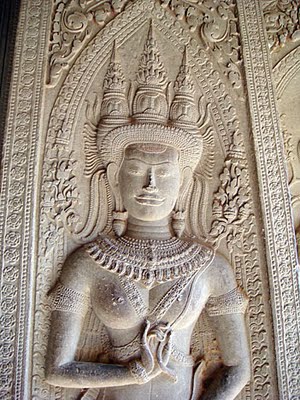 One of the beautiful devata on the walls of the Bakan. There are 1,780 of these celestial goddesses on the walls of Angkor Wat.
One of the beautiful devata on the walls of the Bakan. There are 1,780 of these celestial goddesses on the walls of Angkor Wat.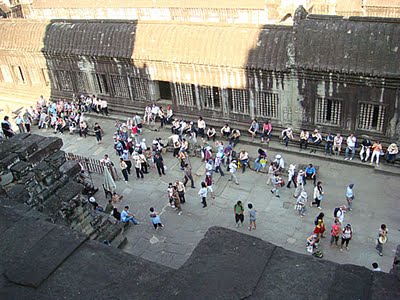 A look at the crowd of tourists taking a breather in the shade having just completed their visit to the Bakan
A look at the crowd of tourists taking a breather in the shade having just completed their visit to the Bakan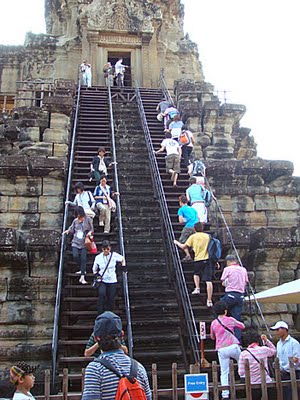 This is the only access point to the Bakan, on the southeast corner of the 2nd storey of Angkor Wat. 100 people are allowed up as 100 come down.
This is the only access point to the Bakan, on the southeast corner of the 2nd storey of Angkor Wat. 100 people are allowed up as 100 come down. 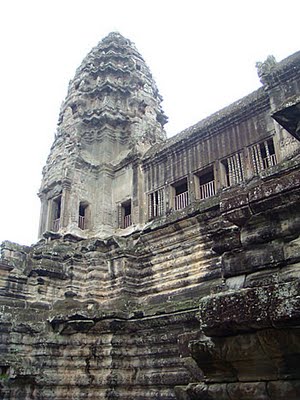 The top level of Angkor Wat, known as Bakan, has been off-limits since Oct 2007. It will re-open on 15 Jan.
The top level of Angkor Wat, known as Bakan, has been off-limits since Oct 2007. It will re-open on 15 Jan.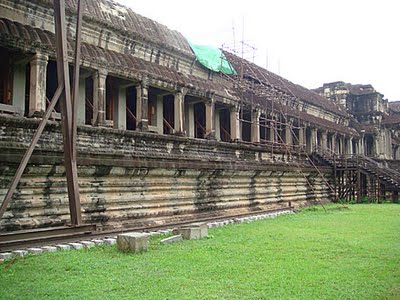 The southern section of the eat gallery which is out-of-bounds until next year. You can see where the water seepage effects the lighter stonework.
The southern section of the eat gallery which is out-of-bounds until next year. You can see where the water seepage effects the lighter stonework.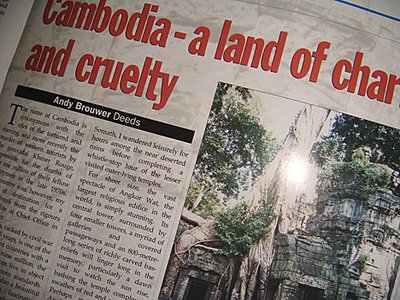 Another article amongst the file of papers I found in one of my unopened packing boxes in my spare room contained a story I wrote for my company's in-house staff magazine called Over The Threshold in their Spring 1995 edition. I was working for the Cheltenham & Gloucester Building Society at the time and I had just made my first-ever visit to Cambodia the previous November. Here's the article, for posterity sake and before I lose it.
Another article amongst the file of papers I found in one of my unopened packing boxes in my spare room contained a story I wrote for my company's in-house staff magazine called Over The Threshold in their Spring 1995 edition. I was working for the Cheltenham & Gloucester Building Society at the time and I had just made my first-ever visit to Cambodia the previous November. Here's the article, for posterity sake and before I lose it. 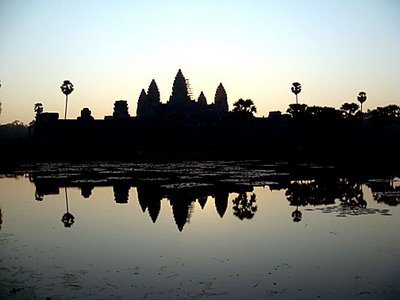 Another shift and the sun drops behind the towers for this photo of the reflection in the north pool
Another shift and the sun drops behind the towers for this photo of the reflection in the north pool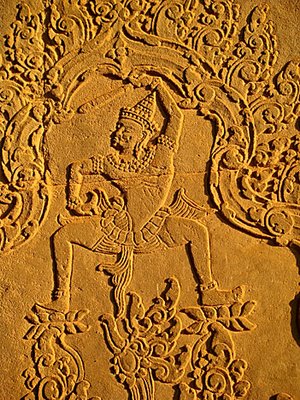 There is so much decoration on the walls of Angkor Wat that it's easy to overlook some of the beautiful artwork that adorns the temple. At the north gate of the west gopura there are some fantastic tapestry carvings worth looking at. This warrior with a conical hat is just one example.
There is so much decoration on the walls of Angkor Wat that it's easy to overlook some of the beautiful artwork that adorns the temple. At the north gate of the west gopura there are some fantastic tapestry carvings worth looking at. This warrior with a conical hat is just one example.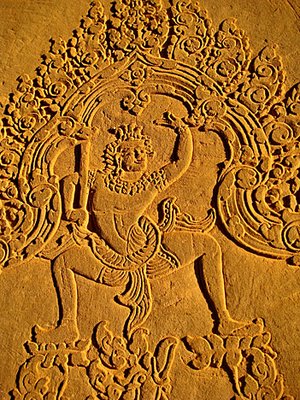 This figure is almost Greco-Roman in appearance in my view. The hairstyle is very unusual. It could be an asura holding a club but doesn't look fierce enough.
This figure is almost Greco-Roman in appearance in my view. The hairstyle is very unusual. It could be an asura holding a club but doesn't look fierce enough.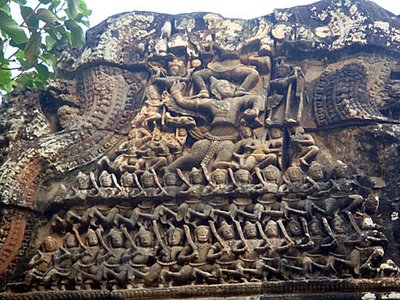 The most lively carving at the south gopura is a headless Vishnu on the shoulders of Garuda and surrounded by an army on the march. This is at the western end.
The most lively carving at the south gopura is a headless Vishnu on the shoulders of Garuda and surrounded by an army on the march. This is at the western end. 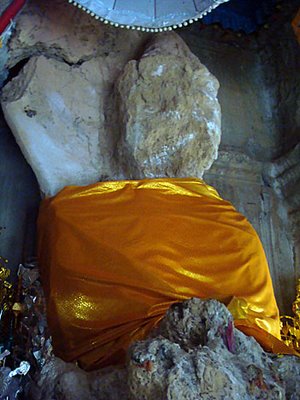 This is the legend of Ta Pech, a malevolent Neak Ta according to my sources. It looked like a big termite mound draped in an orange robe to me.
This is the legend of Ta Pech, a malevolent Neak Ta according to my sources. It looked like a big termite mound draped in an orange robe to me.